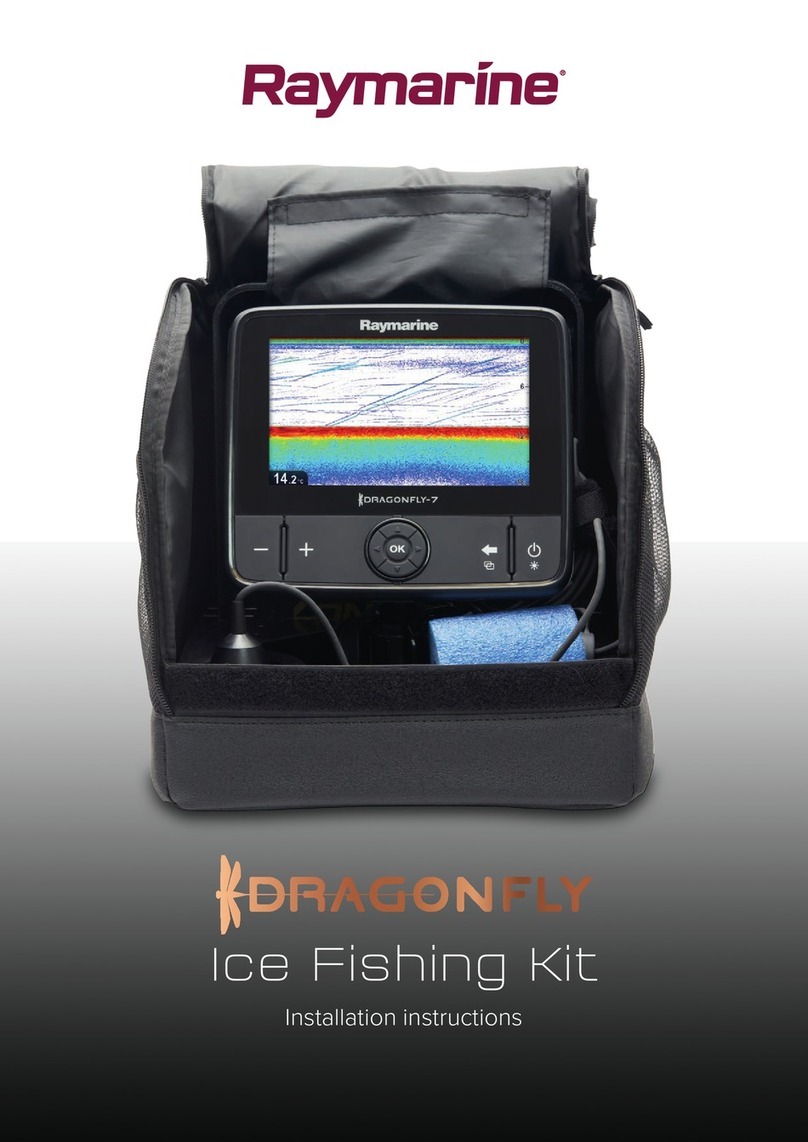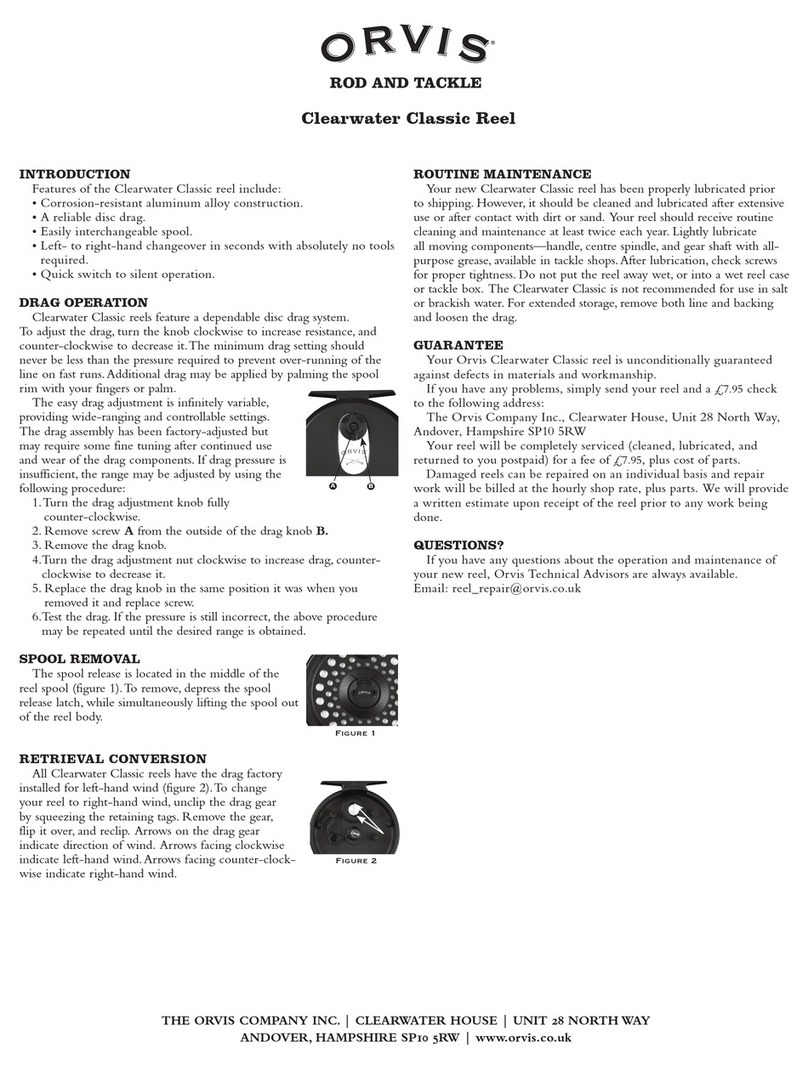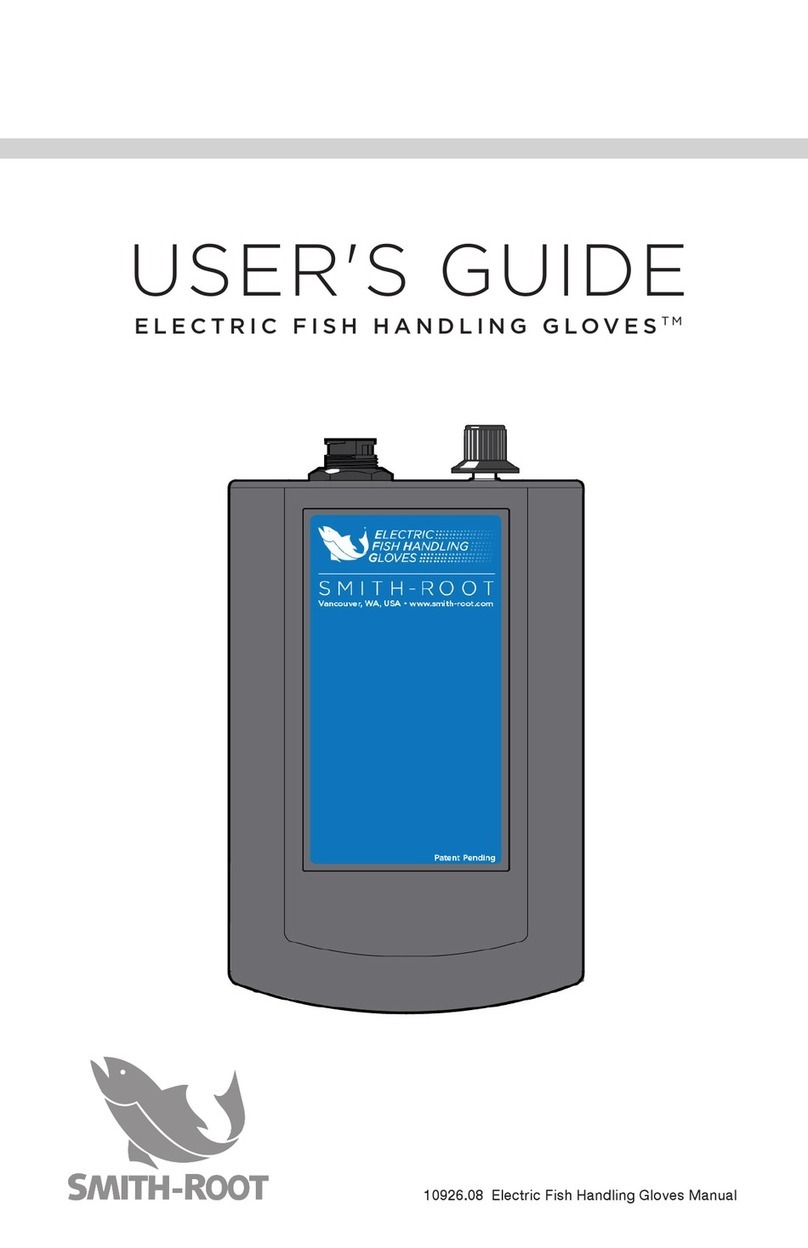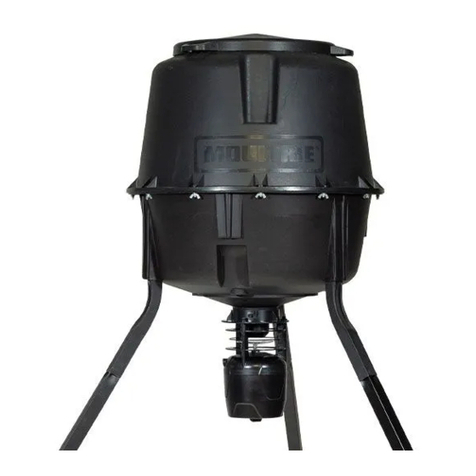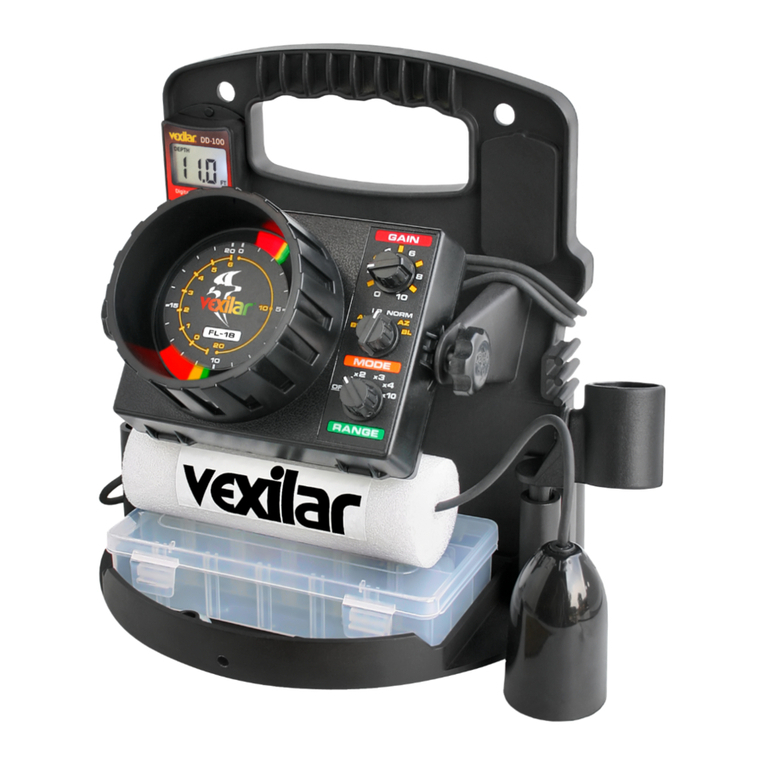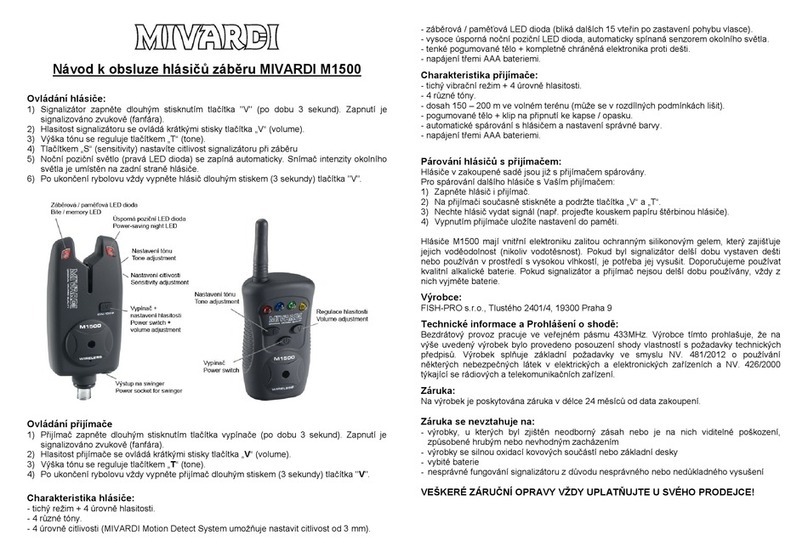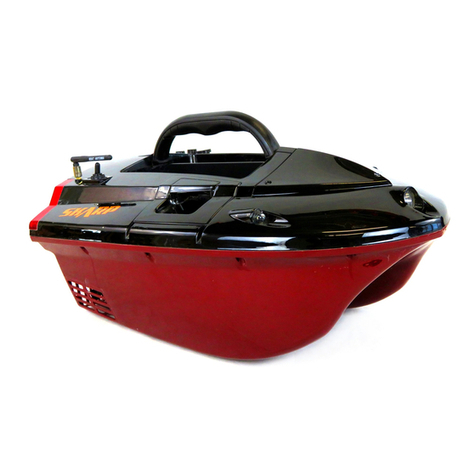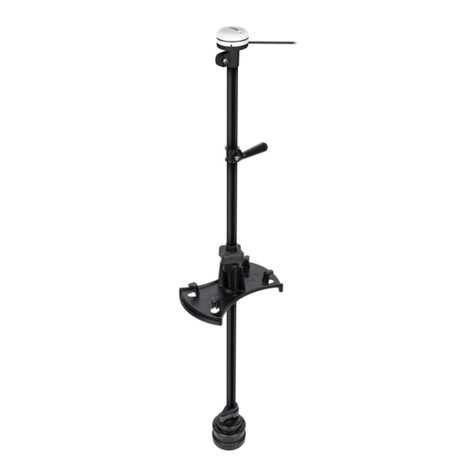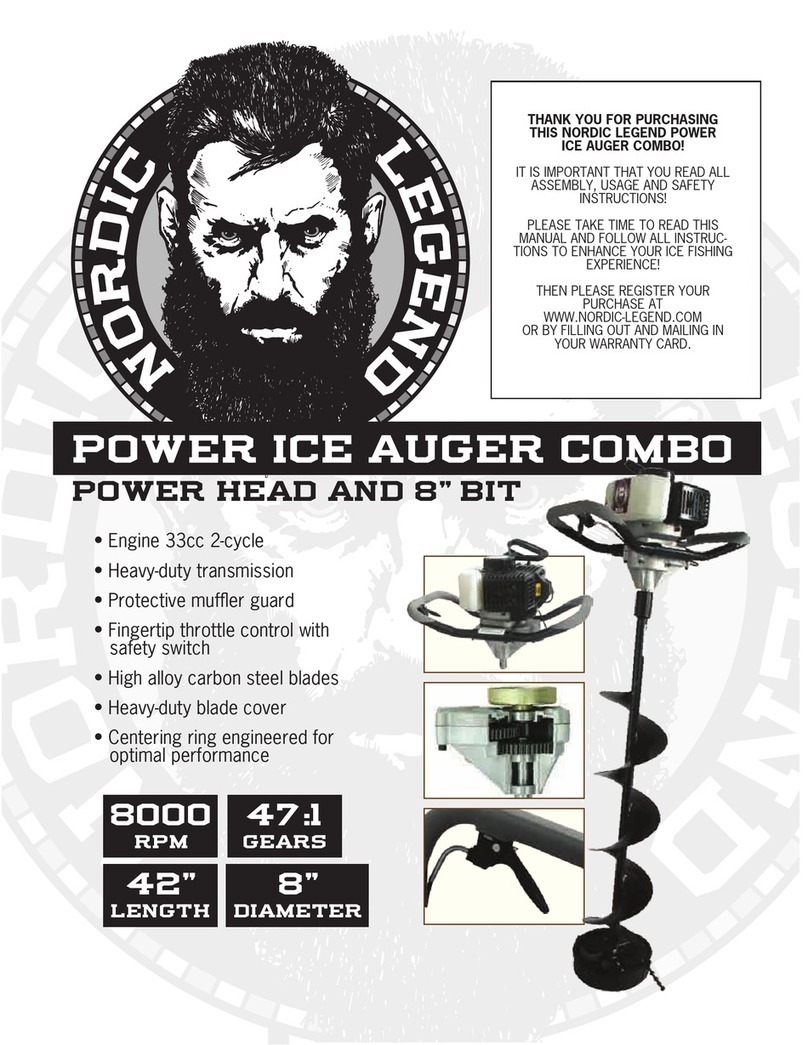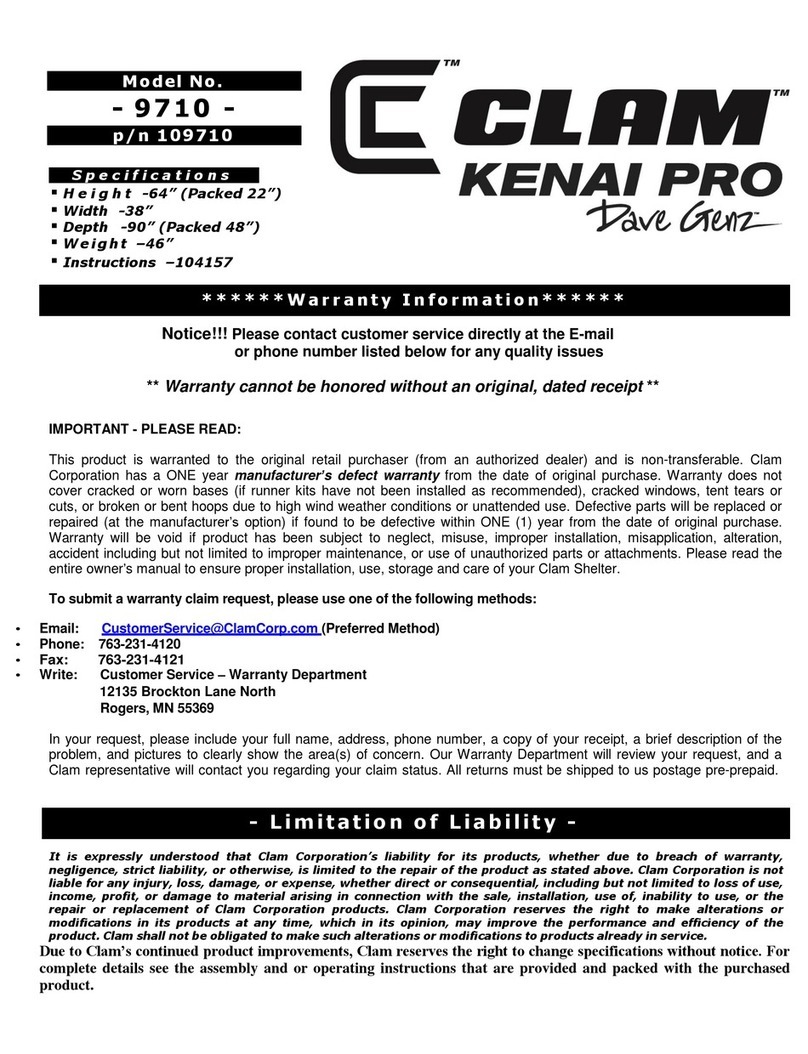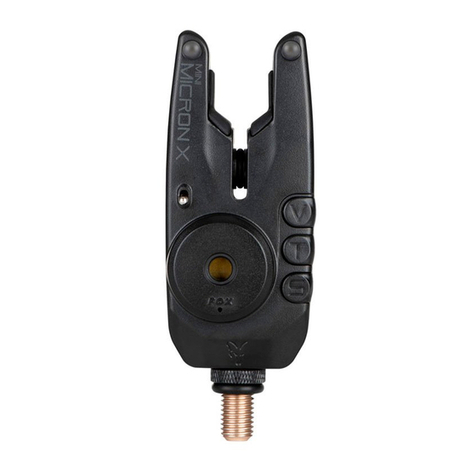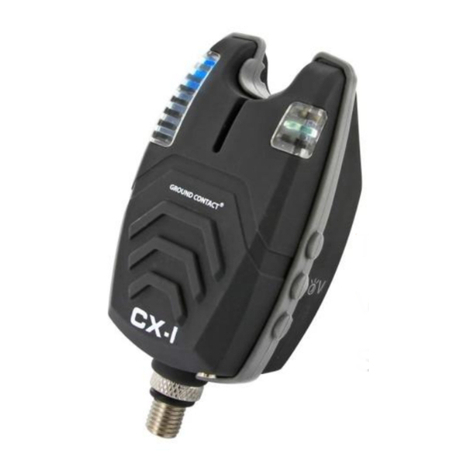Raymarine E66008 User guide

Transducers
for
Fishfinders
Owner’s
Handbook
Documentnumber:81196_2
Date:August2002
All manuals and user guides at all-guides.com
all-guides.com

All manuals and user guides at all-guides.com

Transducers for Fishfinders iii
TransducersforFishfinders
OwnersHandbook
August2002
IntendedUse
The transducer units detailed in this handbook are used in con-
junction with Raymarine fishfinders and are intended for recrea-
tional marine depth, speed, and/or temperature measurement
purposes.
SafetyNotice
This equipment must be installed and operated in accordance with
the instructions contained in this manual. Failure to do so can
result in personal injury and/or navigational inaccuracies.
Raymarine products are supported by a network of Authorized
Service Representatives. For information on Raymarine products
and services, contact either of the following:
United StatesRaymarine, Inc.
22 Cotton Road, Unit D
Nashua, NH 03063-4219
USA
Telephone 603-881-5200
Fax 603-864-4756
www.raymarine.com
EuropeRaymarine Ltd
Anchorage Park
Portsmouth
Hampshire PO3 5TD
England
Telephone +44 (0)23 9269 3611
Fax +44 (0)23 9269 4642
www.raymarine.com
© Raymarine, Inc. 2002
All manuals and user guides at all-guides.com

iv Transducers for Fishfinders
Preface
This handbook describes the transducers that are required for use
with Raymarine fishfinders. A list of currently available fish-
finder transducers appears on page 4.
The handbook contains very important information on the instal-
lation and operation of your new equipment. In order to obtain the
best results in operation and performance, please read this hand-
book thoroughly.
Raymarine’s Product Support representatives or your local dealer
will be available to answer any questions you may have.
The technical and graphical information contained in this hand-
book, to the best of our knowledge, was correct as it went to press.
However, the Raymarine policy of continuous improvement and
updating may change product specifications without prior notice.
As a result, unavoidable differences between the product and
handbook may occur from time to time, for which liability cannot
be accepted by Raymarine.
Raymarine is a registered trademark of Raymarine Limited.
SeaTalk is a registered trademark of Raymarine Limited.
hsb2is a trademark of Raymarine Limited.
Warranty
Your transducer ownership warranty is registered when you fill
out the warranty registration card included with your Raymarine
Fishfinder Owner’s Handbook. It is very important that you com-
plete the owner information and return the card to the factory in
order to receive full warranty benefits.
EMCConformance
All Raymarine equipment and accessories are designed to the best
industry standards for use in the leisure marine environment.
The design and manufacture of Raymarine equipment and acces-
sories conform to the appropriate Electromagnetic Compatibility
(EMC) standards, but correct installation is required to ensure that
performance is not compromised.
All manuals and user guides at all-guides.com

Contents v
Contents
Chapter 1: Overview ...............................................................................1
1.1 Introduction.......................................................................1
General ..............................................................................1
EMC Installation Guidelines ............................................2
1.2 TheFishfinderSystem ......................................................3
Selecting the Correct Type of Transducer .........................4
Planning the Installation ...................................................5
1.3 Unpacking andInspecting the Components .....................6
1.4 Selecting the Equipment Location ....................................6
Transducer Mounting Location ........................................ 6
Transom Mount Transducer .............................................. 7
1.5 CableRuns ......................................................................12
TransducerCable ............................................................12
Chapter 2: Installation..........................................................................15
2.1 Installing the Transom Mount Transducer ......................15
Preparation ......................................................................15
Installation ......................................................................16
2.2 Installing the Thru-hull Transducer ................................17
Tools and Material Needed .............................................17
Preparation ......................................................................17
Installation ......................................................................22
Installation in a Cored Fiberglass Hull ............................29
Check for Leaks .............................................................. 30
2.3 Installing the In-hull Transducer .....................................31
Tools and Material Needed .............................................31
Testing the Selected Mounting Location ........................31
Installation ......................................................................34
Installation in a Cored Fiberglass Hull ............................37
2.4 Transducer CableConnections .......................................39
Chapter 3: Maintenance .......................................................................43
Cleaning Instructions ......................................................43
Servicing and Safety .......................................................43
Problem Solving ............................................................. 44
Common Problems andTheir Solutions .........................44
How to Contact Raymarine .............................................45
WorldwideSupport .........................................................47
Index.................................................................................... 49
All manuals and user guides at all-guides.com

vi Transducers for Fishfinders
All manuals and user guides at all-guides.com
all-guides.com

Chapter 1: Overview 1
Chapter1:Overview
1.1 Introduction
This handbook provides instructions to assist you in the installation
and set up of the various transducers for Raymarine fishfinders.See
Table1-1 onpage 4for a list of the different sensor, material and
mounting types available.
General
Raymarine fishfinders require atransducer, eitherthru-hull,in-hull,
ortransom-mount.
Transducers can measure water depth, temperature, distance
traveled, and/or speed. It is important to position your transducer
correctly, as described in Section1.4, Selecting the Equipment
Location.
Note:If speed and temperatureare beinginput via SeaTalk, these
values are displayed instead of the speed and temperature inputs
from the transducer.
This handbook is divided into three chaptersas follows:
Chapter One provides an overview of the transducer installation.It
includessections on Unpacking and Inspecting the Components,
Selecting theTransducerSiteand a descriptionof theCableRuns.
Chapter Twoprovides detailed instructionson how to mount and
connect each type of transducer.
ChapterThreeprovidesinformationonmaintenanceandwhattodo
if you have problems.
All manuals and user guides at all-guides.com

2 Transducers for Fishfinders
EMCInstallationGuidelines
All Raymarine equipment and accessories are designed to thebest
industry standardsfor usein theleisuremarineenvironment.
Their design and manufacture conformsto the appropriate
Electromagnetic Compatibility (EMC) standards, but correct
installation is required to ensure that performance isnot
compromised. Although every efforthas been taken to ensure that
they willperform under all conditions,it isimportant to understand
what factors could affect the operation of the product.
TheguidelinesgivenheredescribetheconditionsforoptimumEMC
performance, butit is recognized that itmay not be possible to meet
all ofthese conditions in all situations. To ensurethe best possible
conditions for EMC performance within the constraints imposed by
any location,always ensure the maximum separation possible
between different items of electrical equipment.
For optimumEMC performance, it is recommended that wherever
possible:
•Raymarine equipment and cables connected to it are:
•At least 1 m (3 ft) from any equipment transmitting or cables
carrying radio signals,e.g., VHF radios, cables andantennas.
In the case of SSB radios, the distanceshould be increased to
2 m (7 ft).
•More than 2 m (7 ft) from the path of a radar beam. A radar
beam can normally be assumed to spread 20 degrees above
andbelowtheradiatingelement.
•Theequipment issuppliedfroma separatebattery fromthatused
for engine start. Voltage drops below 10 V (20 V for 10 kW open
arrayscanners) inthe powersupplytoour products,and starter
motor transients, can cause the equipment to reset.This will not
damage theequipment,but may causethe loss of some informa-
tion and may change theoperating mode.
•Raymarine specified cables are used at all times. Cutting and
rejoiningthesecablescancompromiseEMCperformanceandso
must beavoided unless doing so is detailedin thedocumentation.
•Ifasuppressionferriteisattachedtoacable,thisferriteshouldnot
be removed.If the ferrite needs to beremoved during installation
it must be reassembled inthe sameposition.
All manuals and user guides at all-guides.com

Chapter 1: Overview 3
The following illustration shows a typicalrange of suppression
ferrites fitted to Raymarine equipment.
Connections toOtherEquipment
If your Raymarine equipment is to beconnected to other equipment
usingacablenotsuppliedbyRaymarine,asuppressionferriteMUST
always be attached to the cable near to the Raymarine unit.
1.2 TheFishfinderSystem
Transducers enable fishfinders to display depth, water temperature
and/or speed, depending on the typeof transducer(s) installed.
Beforeyou start the installation, check that youhave the correct
transducer for your application, as described below in Selecting the
Correct Type of Transducer.
D3548-3
All manuals and user guides at all-guides.com

4 Transducers for Fishfinders
SelectingtheCorrectTypeofTransducer
RaymarineFishfinderscan beusedwithany ofthe following
transducers:
1E66020,E66029andE66043thru-hulltransducersmustbeinstalledwithahigh-
speedfairing.
Note:Thisinformationwascurrentasofthedatethishandbookwas
printed. New transducer models are constantly becomingavailable.
Check with yourdealer for the most current list.
Table1-1:TransducerTypes
Part No. Sensor
Type Material Mounting
Method Max.
Power
E66008 Depth Plastic In-Hull 600W
E66013 Depth Plastic Thru-Hull 600W
E66014 Depth Bronze Thru-Hull 600W
E66015 Depth Stainless
steel Thru-Hull 600W
E66018 Speed,Temp Bronze Thru-Hull 600W
E66019 Speed,Temp Plastic Transom 600W
E660201
Depth,
Speed,Temp Bronze Thru-Hull 600W
E66024 Depth,Temp Bronze Thru-Hull(high
performance) 600Wor
1000W
E660291Depth,
Speed,Temp Bronze Thru-Hull
(longstem) 600W
E66030 Speed,Temp Plastic Thru-Hull 600W
E66033 Depth,Temp Bronze Thru-Hull 600Wor
1000W
E66035 Depth,Temp Bronze Thru-Hull 600W
E66038 Depth,
Speed,Temp Plastic Transom 600W
E660431Depth,
Speed,Temp Stainless
steel Thru-Hull 600W
All manuals and user guides at all-guides.com

Chapter 1: Overview 5
WARNING:
IftheE66020,E66029 andE66043thru-hulltransducersarenot
carefully installed and fitted to the shape of the hull, the vessel
maytakeonwater. Toensureproperalignment and asecurefit,
these transducer models MUSTbeinstalled witha fairing.In
addition to improving fishfinder performance at all speeds, the
fairingallowsbetterfittingtothehullanddramaticallyincreases
thesealingsurface.
Applications
Plastichousings arerecommended for fiberglass or metal hulls.
Bronze housings are recommended forwood or fiberglass hulls.
•Installationofabronzehousinginametalhullrequiresusingofa
fairing,availablefrom yourRaymarine dealer.
•Never installa metalhousinginavesselwithapositiveground
system.
TransomMountTransducersare recommended for personal
watercraft and powerboats with outboard, inboard-outboard and jet
drives. They are NOT recommended for large or twin screw inboard
boats.
•Adjuststo transom angles from 3°–16°. For angles greater than
16°, a tapered plastic, wood or metal shim will be needed.
•Designedforoperationfrom5 –58 m.p.h. (4–50knots).
Thru-Hull Transducers are recommended for boats with straight-
shaftinboard engines.
In-Hulltransducersarerecommendedforfiberglasshulls,especially
in highspeed power boats and racing sailboats.
Planningthe Installation
Beforeyou installyour system, plantheinstallation,considering:
•Location of the transducer and fishfinder, as described in
Section 1.4
•CableRuns,includingcablesforanintegratedsystem(toprovide
heading and position data, etc.), as described in Section 1.5.
All manuals and user guides at all-guides.com
all-guides.com

6 Transducers for Fishfinders
1.3 UnpackingandInspectingtheComponents
Unpack your system carefully, to prevent damage to the equipment.
Save the carton and packing, in case you need to return a unit for
service.
Checkthat youhave allthecorrectsystemcomponents.These
dependon yoursystem package,asfollows:
1E66023fairingsarerequiredforinstallingE66020andE66029bronzethru-hull
transducers.
2E66045fairingsarerequiredforinstallingE66043stainlesssteelthru-hull
transducers.
Note:Thisinformationwascurrentasofthedatethishandbookwas
printed. Check with your dealer for the most currentlist of parts and
accessories.
1.4 SelectingtheEquipmentLocation
TransducerMountingLocation
It is very important that you mount thetransducer correctly. The
transducerprovides themost reliable readings if itlooks into water
thatis smoothandundisturbed.
Table1-2:PartsandAccessories
Item Part
No. Supplied
with: Option
for:
Transducer (
seeTable1-1onpage4)
— — All
Transducer cable, 10 ft (3 m) extension
Transducer cable, 18 ft (5 m) extension
Transducer Y Cable
E66009
E66010
E66022
—
—
Speed/Temp
Transducers
All
All
Allothers
HighSpeedFairing E660231
E660452
E66025
E66034
E26017
—
—
—
—
—
E66020,E66029
E66043
E66024
E66033
E66035
All manuals and user guides at all-guides.com

Chapter 1: Overview 7
Acousticnoiseisalwayspresentandthesesoundwavescaninterfere
withthe operation of the transducer. Ambient(background) noise
from sources such as waves, fish, rain and other vessels cannot be
controlled. Carefully selecting the transducer’s mounting location
can minimize noise generated by the vessel’s propeller(s), shaft(s),
machinery, and other echo sounders.The lower the noise level, the
higher the echo sounder gain that can be used, and the better the
Fishfinder’s performance.
CAUTION:
Toensureaccuratereadings,DONOTmountthetransducerin
an area of turbulence or bubbles:
• nearwaterintakeor discharge openings
• behindstrakes, fittings or hullirregularities
• behind eroding paint (an indication of turbulence)
Choosea location where:
•Thewaterflowingacrossthehullissmoothestwithaminimumof
turbulence and bubbles (especially at high speeds).
•The transducerwill be continuously covered by water when the
boat is moving. If the transducer is mounted near the side of the
boat, itmay be exposed when the boat is turning.
•The transducerbeam is unobstructedby the keel or propeller
shaft.
•There is a minimum deadrise angle.
•Thereisadequateheadroominsidethevesselfortheheightofthe
thru-hull housing,tightening the nuts,and removing the valve
assembly insert.
TransomMount Transducer
•Singledriveboat- Refer to Figure 1-1. Ifyour boathas onepro-
peller(outboardorinboard),mountthetransducerabout18"(455
mm)to the sideoftheboat’s centerline. To reduce any interfer-
encecaused byair bubbles,choosethesideon thedownstrokeof
the propeller (usually the starboard side).
•Twindrive boat- If your boat has twin propellers (outboard or
inboard-outboard),mountthetransducerbetweenthedrivesnear
the centerline of the boat. If the boat will be operated at high
speeds,thetransducermaybemountedclosertothecenterlineof
the hull.
All manuals and user guides at all-guides.com

8 Transducers for Fishfinders
•Ifthepropellercanbeturnedtosteertheboat,allowatleast2"(50
mm) beyond the swing radius of the propeller. This will prevent
the propeller from damaging the transducer when it is turned.
Figure1-1: TransomMountTransducerLocation
•DoNotmount the transducer behindany hull fittings, intakes or
other parts extending from the hull thatmay cause turbulence or
airbubbles.
•The bracket has aquick-release mechanism, shown Figure 1-2 .
This allows the transducer to flip up if it hits any debris or the bot-
tom.Allowenoughclearanceabovethetransducerforittoswing
upwardscompletely–thisisabout10"(254mm),measuredfrom
the bottom of the transom.
Be sure to allow at
least 2 in (50 mm)
beyond the swing radius
of the propeller
Approximately 18 in (457 mm) clearance
D4871-2
All manuals and user guides at all-guides.com

Chapter 1: Overview 9
Figure1-2: TransomMountTransducer-Quick-releaseBracket
•Onaboatwithafiberglasshull,theleadingedgeofthetransducer
shouldextend1/8" (3.2mm) to1/4"(6 mm) belowthe bottom
edgeofthehullasshowninFigure1-3.Onanaluminumhull,the
transducer should extend a bit more –1/4"(6 mm)to 3/8"(9mm)
•If the boat will be trailered, be sure the transducer will not hit any
rollers, bunks or fittings on the trailer.
Figure1-3: TransomMountTransducer-VerticalPosition
D4872-2
Transducer in
released position
Allow a clearance of
at least 254 mm (10 in)
No!No!No!
Average transom angle -
no wedge necessary Vertical transom -
place wedge this way Sloping transom -
place wedge this way
2° to 5°
2° to 5°
For fibreglass hull 1/8 to 1/4 in (3.2 to 6 mm)
For aluminium hull 1/4 to 3/8 in (6 to 9 mm)
The bow of the transducer
is above the bottom of the
transom, creating cavitation.
Rivets on the hull are
creating bubbles. Lower
the transducer a bit.
The rear of the transducer
is too high, creating
cavitation.
D4873-2
2° to 5°
All manuals and user guides at all-guides.com

10 Transducers for Fishfinders
Thru-hullTransducerandIn-hullTransducer
Similarconsiderationshouldbegiven tothelocationofthru-hulland
in-hulltransducers.Figure1-4 showsthebesttransducerlocationfor
different hull types.
•Displacementhullpowerboat –Locate at 1/3 aft load waterline
length(LWL) and6 - 12"(150-300mm)offthecenterlineonthe
side ofthe hull where the propeller is moving downward.
•Planing hullpowerboat–Mountwell aft, onor near thecenter-
line, and well inboard of the first set of lifting strakes to ensure
that it is in contact with thewater athigh speeds.Mount on the
side ofthe hull where the propeller is moving downward.
OutboardandI/O–Mountjustforward ofthe engine(s).
Inboard–mount wellforward ofthe propeller(s) andshaft(s).
Step-hull –Mount justahead ofthe firststep.
Boatscapableof speedsabove25kn(29m.p.h.)–Review
transducer location and operating results of similar boats before
proceeding.
•Finkeelsailboats–Mountto the sideof thecenterline andfor-
ward ofthe finkeel 1 -2 ft (300-600 mm).
•Fullkeelsailboats–Locateamidshipsandawayfromthekeelat
thepointof minimumdeadrise angle.
•FiberglassHulls –Since the hull absorbs acoustic energy, trans-
mitting through thehull reducesthe sensor’s performance.Fiber-
glasshullsareoftenreinforcedinplacesforaddedstrength.These
coredareascontainbalsawoodorstructuralfoam,whicharepoor
soundconductors.If youcannot avoidlocating thesensorover
coring,followthe instructionsforInstallation in a Cored Fiber-
glass Hull on page 29.
•Thru-hullTransducerHeadroom–Allow adequate headroom
insidethevesselfortheheightofthethru-hullhousing,tightening
the nuts and removing the insert. The minimum headrooms are:
With fairing:10"(254 mm)
Without fairing:12" (305 mm)
•In-hull Transducer –Find a location where the fiberglass is
solid:
There are no air bubbles trapped in the fiberglass resin.
There is no coring, flotation material, or dead air space sand-
wiched between the inside skin and the outer skinof the hull.
All manuals and user guides at all-guides.com
all-guides.com

Chapter 1: Overview 11
Figure1-4: BestLocationforThruHullTransducer
1/3 Aft
Load waterline length (LWL)
Pressure waves
6--12in
(150 -- 300 mm)
Displacement hull
Planning hulls
Outboard and I/O Inboard
Step hull Fin keel sailboat
Full keel sailboat
D4857-2
All manuals and user guides at all-guides.com

12 Transducers for Fishfinders
1.5 Cable Runs
Consider the following before installing the system cables:
•You need to attach the power cable and the transducer cable.
Additional cables will berequired ifyou are installing an inte-
grated system.
•Allcablesshouldbeadequatelysecured,protectedfromphysical
damage and protected from exposure to heat. Avoid running
cables throughbilges or doorways,or close to moving or hot
objects.
•Acute bends must be avoided
•Where a cable passesthrough anexposed bulkhead or deckhead,
awatertight feed-through shouldbe used.
•Secure cables in place using tie-wraps or lacing twine. Coil any
extra cable and tie it out of the way.
TransducerCable
A 30 ft (10m) cable is supplied with the transducer. The transducer
cablemaybeextendeduptoamaximumof60ft(20m)using
optionalextension cables.
Thetransducercableconnectorhasanutthathasbeenremovedtoaid
installation.Toallowyou tocompletetheinstallationwithoutcutting
the cable, ensure that any holes youdrill arelarge enough to accept
the connector, with thenut removed.
After thecable has been run through the holes, thisnut must be
attached before the cable can be connected, as described in
Transducer Cable Connections onpage 39.
CAUTION:
Donotcutthetransducercableorremovetheconnector.Donot
trytoshorten or splice thecable.Ifthecableis cut, itcannotbe
repaired.Cuttingthecablewillalsovoidthewarranty.
•ForaTransommountinstallation–routethecableupandoverthe
top edge of the transom as shown in Figure 1-5 . Secure the cable
using cable clamps (available from your local marine equipment
supplier).
All manuals and user guides at all-guides.com

Chapter 1: Overview 13
Ifyou donotwantto exposethe cableon deck,you maydrill a
hole13/16"(21 mm)throughthetransomforthecable(withcon-
nector attached). To seal the opening, use a feed-thru cap where
thecable passesthroughthe transom.
•For either type of installation –runthecable through the interior
ofthe boat.
•Ifthe 30 ft (10 m) cable isnot longenough, extension cables are
available from your Raymarine dealer. See Table1-2onpage 6.
Total cable length fromthe transducer to the fishfinder must
notexceed60ft(20m).Whenyouattachthe extensioncable,be
sure that the connections arewatertight.Use Dow Corning DC-4
or anequivalent sealing compound to protect the connector
assemblies.
Figure1-5: InstallingtheCableonaTransomMountTransducer
D5033-2
Cable cover
Cable clamps
2 in (50 mm)
All manuals and user guides at all-guides.com

14 Transducers for Fishfinders
All manuals and user guides at all-guides.com
This manual suits for next models
13
Table of contents
Other Raymarine Fishing Equipment manuals
Popular Fishing Equipment manuals by other brands
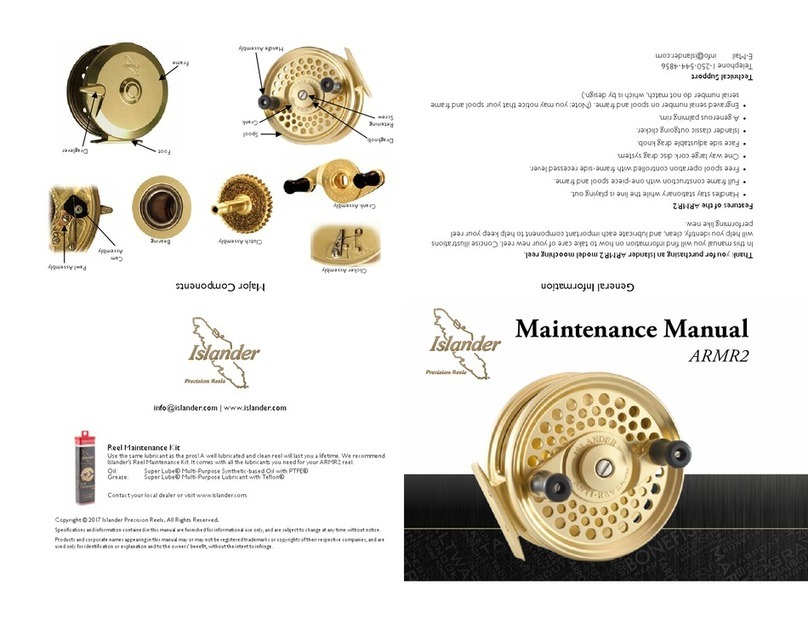
Islander
Islander ARMR2 Maintenance manual

FISHING SPECIALTIES
FISHING SPECIALTIES Bowducer installation instructions
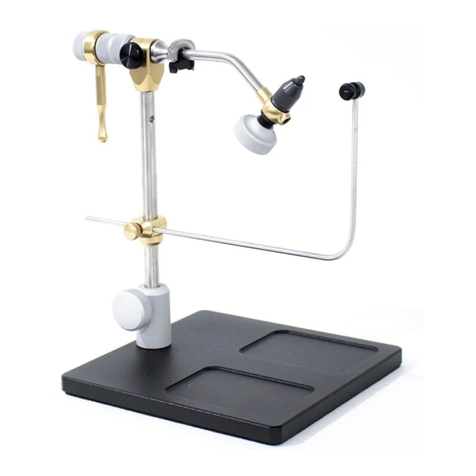
Renzetti
Renzetti Presentation True Rotary 3000 Series quick start guide

MIVARDI
MIVARDI Carp Scout XL instruction manual

Shappell
Shappell Wide House 6500 SETUP & TAKEDOWN INSTRUCTIONS

Brand Developers Limited
Brand Developers Limited Conrad Meier Fish Harvester owner's manual
